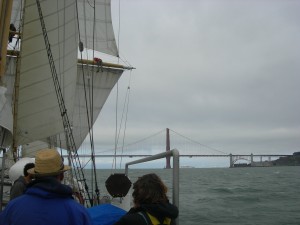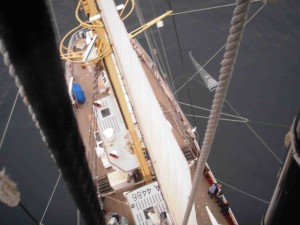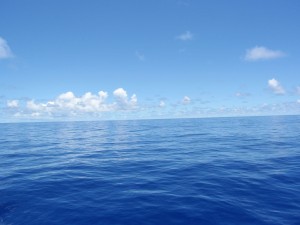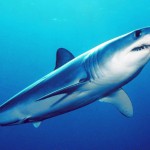
Hello internets! I am back from a month of sailing from Hawaii to California on the tall ship SSV Robert C. Seamans. The Seamans is run by the Sea Education Association, where undergraduate and high school students can learn oceanography, maritime history, and seamanship aboard one of two gorgeous tall ships, one in the Atlantic, one in the Pacific. (The Southern Fried Scientist is an alumnus – anyone else out there?). The SEA vessels are well-equipped for research (PDF) with all the standard tools of oceanography – CTD, ADCP, winch & hydraulic J-frame, and so on – though it definitely is more challenging to maneuver under sail than by burning tons and tons of diesel fuel.
I was on board as a visiting researcher, continuing my work on the impact of plastic debris on zooplankton in the North Pacific Central Gyre. I did as many plankton tows as time allowed at the surface of the water, filtered lots of seawater to look for plastic particles too small to be caught by the net, and tested live zooplankton to see if they were ingesting plastic. I don’t know what the results are yet – in order to make the most of my time at sea, I just preserved samples as fast as possible, and will go through them now that I am back at the lab. (Also, looking in a microscope at sea makes me hurl.)

I was totally off the grid while at sea, so instead of trying to capture the full experience, I’m going to do a couple of posts on selected awesome moments and fantastic critters. If you want to know more, just ask in the comments – I can answer there or as an additional post. You can also check out SEA’s excellent Plastic blog for more on science under sail.
Awesome Moment #1
The cruise track was great for my work – we had to sail right through the north-center section of the gyre – but not so great for sailing. After we lost the trade winds north of Hawaii, we experienced very little wind until we got into the westerlies not far from California. I’m used to motoring around and it didn’t bother me much, but of course a tall ship is meant to sail, so the sailors (students as well as staff) all pined away for the wind.

The lack of wind did produce one glorious, wonderful moment – SWIM CALL! Swimming is strictly forbidden in the US research fleet due to a tragic incident with a white shark, so I’d never been swimming in the open sea before. (No, I was not worried about sharks. We had people acting as lookouts, visibility was amazing, and shark attacks are vanishingly, vanishingly rare.)
Conditions had to be exactly right to assure everyone’s safety, but we were lucky and the captain decided that the flat calm sea and lack of shark sightings meant that we’d be able to swim. Here I am paddling about, nothing between me and the giant isopods of the abyssal plain except 4000 meters of water.

I managed to borrow a mask & snorkel to hunt for jellies. I didn’t find any (though one of the other scientists did), but I did see single-celled acanthareans floating about, feeding with long pseudopods. It was incredibly cool to see these organisms alive and happy – it’s easy to forget that what we see catch in a net and store dead in a jar is very, very different than what exists in the ocean.
Next: ATTACK OF THE PTEROPODS!!!
[cross-posted at the SEAPLEX blog]






sweet…I’m an SEA alum…W-135 (1994). The Westward has since been retired but she was the first and the best! SEA is a great organization and SEA Semester is one of the best things I ever did – nothing like learning how to handle adverse situations than on a schooner in the middle of the Atlantic, 1000’s of miles from land, in the middle of a squall, with a torn mains’l…or being seasick in 30-ft seas during a force 10 gale. Ah, the memories! Glad you connected with them.
Jim! Your alive! I haven’t seen or heard from you in what seems like years! Cheers, Mate.
Hey Jim! I agree – wish I’d done SEA Semester as an undergrad. It is a super cool program – inspired me to try to learn a little celestial navigation on my own.
Hey KZ, Dr. M – yeah, it’s been a while – somehow I completely fell off the blogosphere – just way too many other things that require my attention I guess – I haven’t posted anything of my own in over a year. Wish I could say I will be returning regularly, but clearly, given it’s already been almost two weeks since my last visit, that is unlikely. I miss you guys though :) Perhaps I will just need to force myself back into things…we’ll see.
Anyways, I can’t say enough good things about SEA – even more than the practical oceanographic experience, the program teaches you seriously important life lessons – like a winch is geared to only turn in one direction and that forgetting which direction that is in the middle of a storm has disfiguring potential (though luckily, SEA also has well-qualified mates to jump in to prevent said disfiguration). Every aspiring marine scientist should be required to take part in SEA – hell, maybe every undergrad should – you’ll learn more about yourself, teamwork, responsibility, and leadership than any course will ever be able to teach you.
sorry…meant “Hey KZ, Miriam” (but “Hey” to you too Dr. M!)
S’ok – I’m often confused with large bald men. ;)
So glad to hear from you! Welcome back. I just wondering the other day about you and where the invertebrate wars went!
I thought we all agreed that echinoderms were the coolest, so there was peace throughout the invertosphere :)
And Miriam – I saw those comics – no way anyone mistakes you for a large bald man ;)